
Are you tired of spending months or years developing a product that might never take off? You are not just investing your time, but you're also committing significant resources, including finances, continuous research, and testing efforts. Investing heavily in development without knowing if your idea will resonate with the market can be risky.
According to a recent study at Investopedia 90% of startups fail due to a lack of market fit. This is a common dilemma faced by businesses and entrepreneurs alike.
The Minimum Viable Product (MVP) approach offers a more efficient and strategic path to success. Instead of investing heavily in a fully-fledged product, invest your resources in building an MVP, which allows you to launch a basic, functional version early on to test your idea and gather valuable feedback.
Think of it as a "test run" for your product. By focusing on the core features and essential functionalities, you can quickly validate your assumptions, identify potential issues, and iterate based on real-world user input. This mvp building approach has been instrumental in the success of countless startups, including industry giants like Dropbox, Uber, and Airbnb.
In this blog post, we'll dive deeper into the MVP concept, explore its benefits, and provide practical tips for building your own MVP. So, if you're ready to revolutionize your product development process, let's get started!

What is an MVP Product?
A Minimum Viable Product (MVP) is a foundational concept in product development that involves launching a simplified version of a product or service with just enough features to satisfy early users. Businesses can test key hypotheses, validate assumptions, and conserve resources by focusing on essential functionality and gathering valuable feedback.
A Minimum Viable Product (MVP) emphasizes efficiency and learning from customer feedback with minimal initial investment. When building an MVP, businesses must balance simplicity with comprehensiveness to attract early adopters and provide valuable insights without the complexity and cost of a fully developed product.
For example, Dropbox started as a simple MVP demonstrating its file-sharing functionality. By gathering feedback from early users, Dropbox was able to refine its product and expand its features to meet the needs of a growing user base.
An MVP is a strategic tool for businesses to develop and launch successful products efficiently. By focusing on core features, gathering early user feedback, and iterating based on insights, businesses can reduce risk, accelerate time to market, and increase the chances of achieving product-market fit.
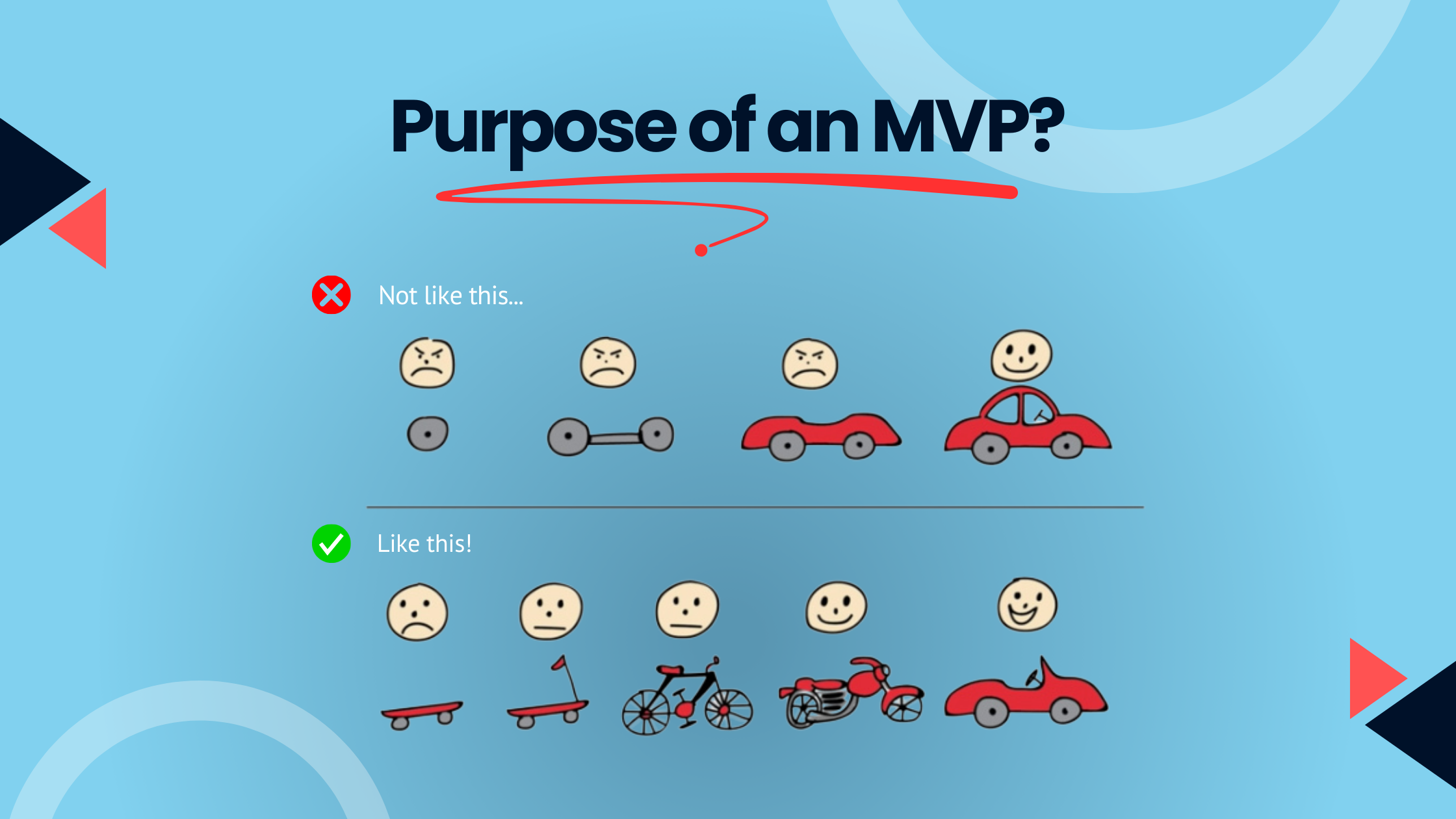
What is the Purpose of Building an MVP?
The purpose behind building an mvp is to launch a product quickly and efficiently, based on an established idea, with a limited budget. By releasing a simplified product version, businesses can gather valuable feedback from early users and incorporate it into future iterations.
The skateboard analogy from Henrik Kniberg serves as a visual representation of the MVP approach. Just as a skateboard can serve as a basic form of transportation, a minimum viable product can provide a functional, simple solution to the user's needs. By starting small and iteratively adding features, businesses can ensure that the product is providing real value at each stage of development.
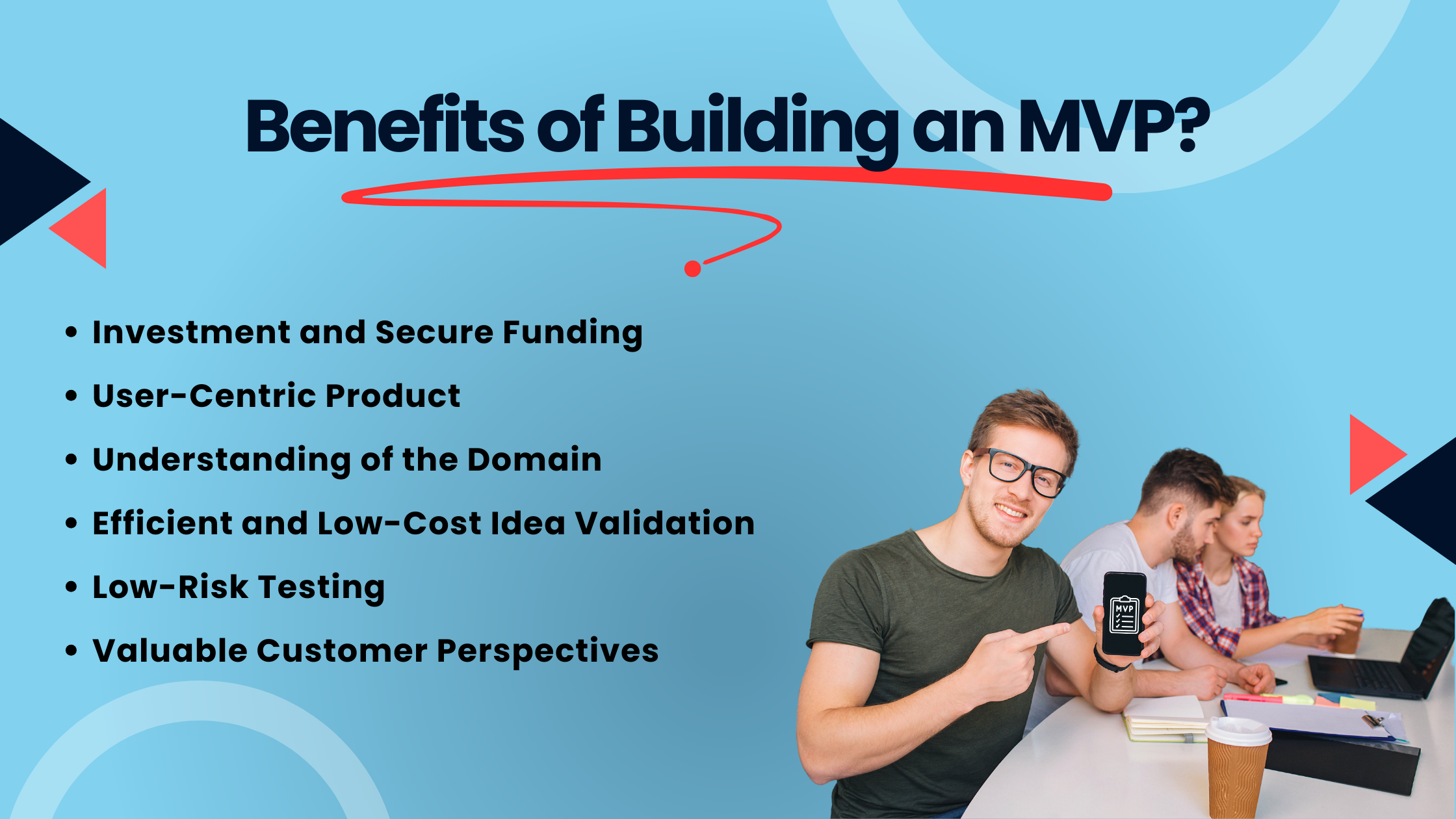
The Benefits of Building an MVP
The benefits of building an mvp go beyond mere cost savings and speed to market. It offers a strategic approach to product development by focusing on core features and gathering early user feedback. By building an MVP, businesses can ensure that their products resonate with customer desires.
The following are the benefits of building an mvp
An MVP Helps Find Investment and Secure Funding
A well-developed MVP product is often the key to capturing the investor's attention and securing startup funding. Demonstrating a functional MVP helps investors grasp the potential of your business. This approach not only highlights the potential of your MVP but also showcases your team's ability to execute it, boosting investor confidence and making it easier to secure startup funding.
Build a User-Centric Product That Delivers Value
Founders often have a clear vision of their final product and can become emotionally attached to that idea. However, to create a product that truly resonates with users, this vision must remain adaptable. By creating an MVP and gathering valuable feedback from users, you can focus on implementing only the most crucial features and eliminating anything unnecessary or non-functional.
Building a Stronger Understanding of the Domain
Building an mvp gives you the leverage to thoroughly explore the underlying problem, industry dynamics, and market landscape. This process enhances your domain knowledge and helps identify potential gaps in the market. Jumping straight into creating a comprehensive product may lead you to overlook these valuable opportunities.
Efficient and Low-Cost Idea Validation
Building an MVP involves incorporating only the essential features needed to test an idea, which reduces the time required for its construction. By focusing on the critical elements of the product, you allocate time and resources effectively. An MVP represents the most cost-effective version of the product, allowing you to see how real users will respond to it.
A Platform for Low-Risk Testing
A minimum viable product provides the flexibility for evolution. Firstly, if new technologies emerge, you can seamlessly integrate them into your product. Secondly, it’s simpler to add new features than to eliminate those that are no longer needed. Essentially, an MVP maintains the product concept's adaptability to accommodate the latest changes.
Gain Valuable Customer Perspectives
Gathering customer feedback is vital for businesses to thrive. A minimum viable product provides a platform for engaging early users and collecting valuable data. This feedback helps startups understand customer preferences, prioritize product features, and ensure market relevance.
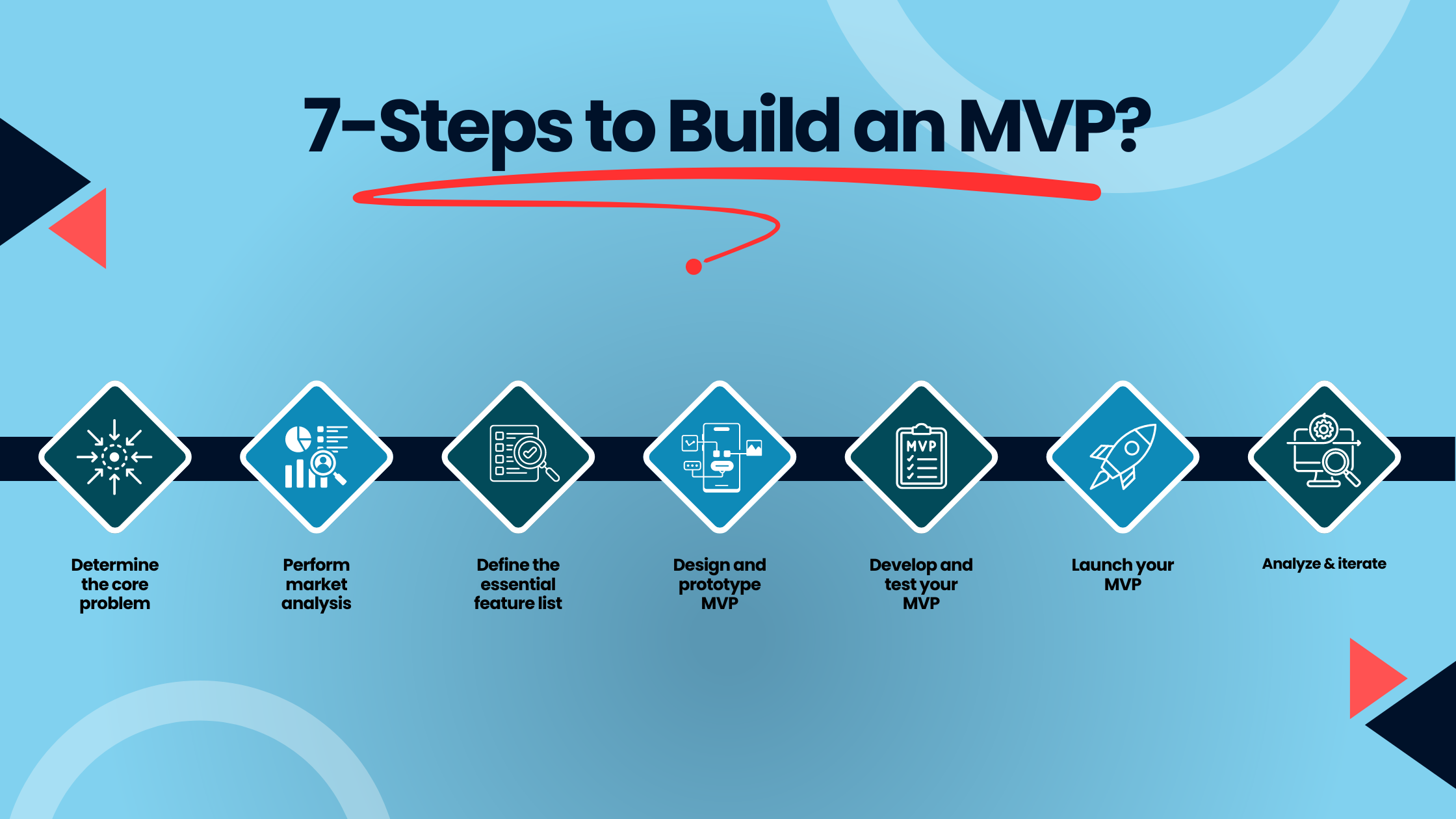
Steps to Build an MVP
A minimum viable product is a powerful product designed to rapidly enter the market, test key hypotheses, attract early adopters, and achieve product-market fit. However, successfully navigating this mvp development process requires a strategic understanding of both your product vision and the market landscape. Too often, startups launch a basic sub-domain website with little content, label it as an MVP, and when it fails to gain traction, they blame the MVP building approach. The real problem isn’t the MVP concept itself but rather a failure to grasp the essential steps of the MVP development process. By following well-defined steps to build an mvp, you can avoid these common mistakes, build a robust MVP, and position your product for long-term success.
The following steps are essential for building an mvp
Determine The Core Problem You Want To Address
The first step for building an MVP is clearly defining the problem you're trying to solve. This forms the foundation of the MVP development process and helps determine the essential features. While identifying the problem seems simple, aligning the solution with market needs can be challenging.
Before beginning the MVP development process, it’s crucial to validate that your idea aligns with the needs of your target users. This can be achieved through thorough surveys and market research. Additionally, evaluate your competitors to identify opportunities for your product to differentiate itself. By clearly defining the problem and validating your concept, you significantly improve the chances of building a successful MVP.
Perform Market Analysis
Building a successful MVP requires validating both the problem and the solution through comprehensive market analysis. By understanding your target audience and their pain points, you can ensure that your product effectively addresses their needs.
In addition to gathering customer insights, studying competitors will help you identify gaps in the market where your MVP can stand out. It's essential to test early assumptions and pivot when necessary, ensuring that your minimum viable product aligns with market demand before committing significant resources.
This proactive approach reduces risk and enhances the likelihood of building an mvp that aligns with the market and fosters sustainable growth.
Prioritize and Define the Essential MVP Feature List
Once you’ve prioritized the essential features for your MVP, it's important to avoid unnecessary features by focusing only on what’s necessary. Adding too many unnecessary functionalities can increase complexity and delay development. Keeping the MVP lean ensures that development time and costs remain manageable while solving the core problem for your target users.
Story mapping is an effective tool for organizing and prioritizing features. By plotting the user journey along a horizontal axis and arranging features by priority on a vertical axis, you can clearly visualize which functionalities should be developed first. This approach ensures the MVP focuses on delivering the most essential features, helping to streamline development and maintain clarity throughout the mvp development process.
Beyond story mapping, it’s crucial to categorize features by their importance. Group them into high, medium, and low priority, and then organize them in the product backlog accordingly. This ensures the MVP emphasizes the core functionalities that directly address user needs, while secondary features can be reserved for future iterations, keeping the focus on solving the primary problem first.
Design and Prototype The MVP
After moving past the ideation stage, prototyping becomes a critical step in identifying potential issues early. Whether it's a basic sketch or a detailed interactive wireframe, a prototype allows you to visualize your product's functionality and gather valuable feedback before fully committing to development. This approach ensures you're addressing the right problem without investing excessive time or resources upfront.
A prototype and an MVP serve different purposes. While a prototype validates design and user experience, an MVP is a functional version of your product that tests your business idea in real-world conditions. Both tools are essential—prototyping helps refine your vision, while the MVP confirms its viability with actual users.
Combining both approaches—prototyping first and then building an MVP- ensures that your product meets user expectations and is well-positioned for success in the market.
Develop and Test Your MVP
After finalizing the MVP’s features and completing development, the focus shifts to launching and gathering feedback. It’s crucial to introduce the MVP to the market with a well-thought-out plan that includes testing, bug fixing, and promotion strategies. A stable, polished MVP will allow users to experience its core functionalities without disruptions. Launch it across appropriate channels such as websites or app stores, ensuring it is accessible to your target audience.
User testing is a crucial part of this stage, as it provides valuable feedback on the MVP and helps pinpoint any problems or areas that need refinement. By leveraging this feedback, you can enhance the MVP, ensuring it aligns with the needs and expectations of the target audience.
Nielsen Norman Group suggests that conducting user testing with just five users is effective for identifying usability problems, as each participant plays a significant role in uncovering key insights. Conducting user testing boosts the chances of success by ensuring the MVP is easy to use and effectively addresses the needs of the target market.
Lastly, understanding the type of MVP you’re launching, such as a website, app, or landing page, will significantly influence the development timeline and scope. By balancing development quality with customer-centric features, you ensure the MVP is a true reflection of your product's potential, setting the stage for future success.
Launch Your MVP
Once done with building an mvp, the next critical step is to launch it in the market, and a successful launch is essential to gather real-world data on the product's performance and its ability to meet the identified user needs.
A successful launch requires a two-pronged approach: comprehensive testing to ensure the MVP's quality and a strategic marketing plan to increase visibility and attract customers.
To ensure a successful launch, consider various distribution channels like websites, app stores, or direct sales. A comprehensive marketing plan and a feedback loop for continuous improvement are essential elements.
Analyze And Iterate
After launching the MVP, it is time to analyze its performance and gather customer feedback
This MVP building phase involves gathering data on user engagement, customer feedback, and product usage. These insights will help identify the product's strengths, weaknesses, and areas for improvement
To effectively asses the product performance, tracking key metrics such as user engagement, conversion rates, and retention is essential. These metrics offer valuable insights into how users are interacting with the product and its overall effectiveness.
It's also crucial to collect user feedback through methods like surveys, interviews, or user testing. This provides valuable qualitative insights into how users interact with the product and highlights any pain points or frustrations they may encounter.
Following the analysis, the product team can implement necessary changes and enhancements to the MVP. This continuous cycle of testing, analyzing, and refining is vital for improving the product and increasing customer value. The process is repeated until the MVP evolves into its final version.
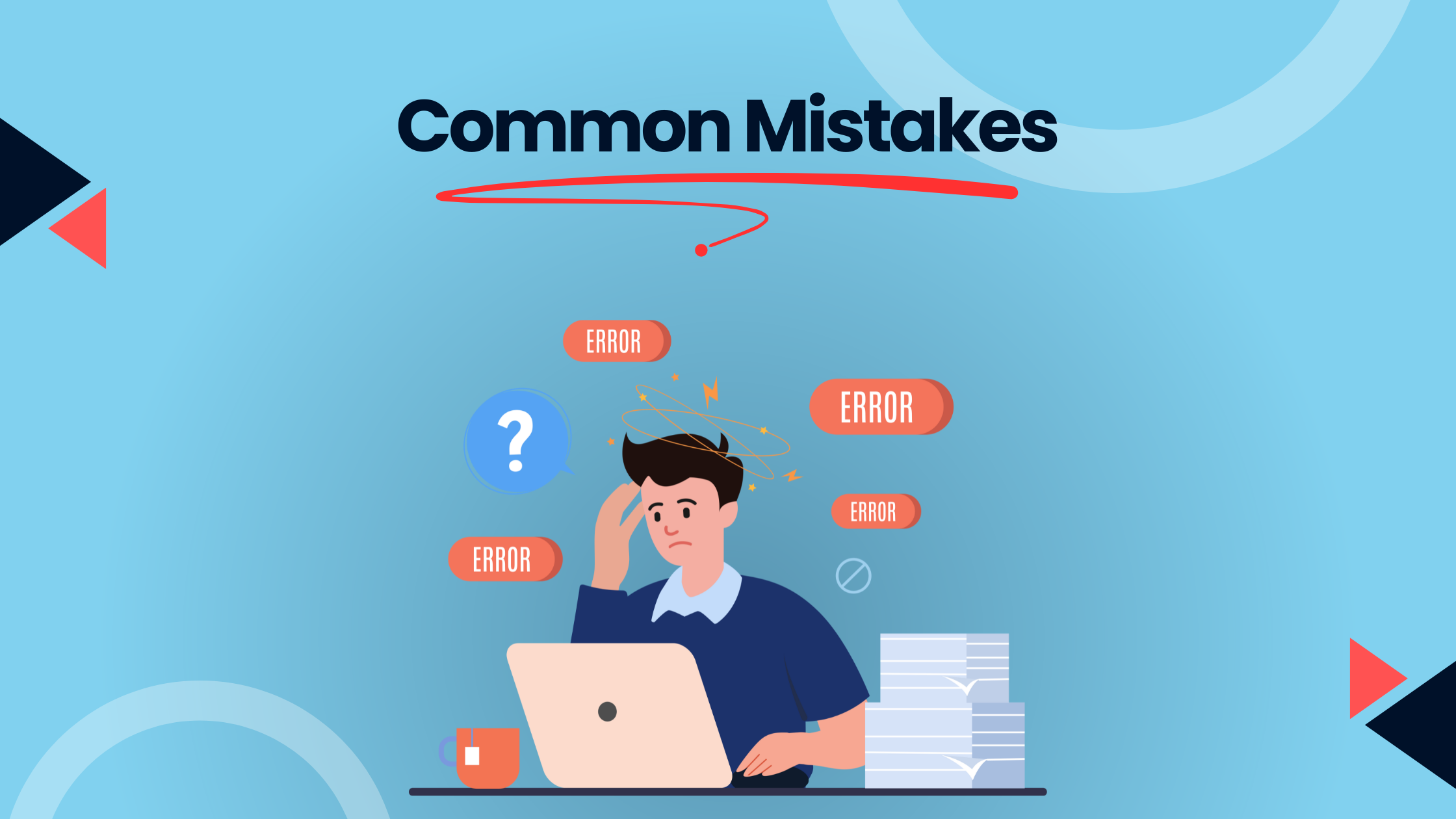
Mistakes to Watch Out for When Building an MVP
In today’s fiercely competitive digital commerce landscape, Darwin’s ‘Survival of the Fittest’ perfectly summarizes the challenge businesses face. The MVP development process enables leaders to validate their product’s value without a heavy investment of time or money. However, for successfully building an mvp, it's crucial to avoid certain mvp development mistakes that could result in a significant business failure.
The following are the mistakes that one should avoid when building an MVP
Ignoring User Feedback
It may seem straightforward, but it's crucial to pay attention when users start offering feedback.
A common issue arises when founders are overly focused on building the solution they envision, rather than addressing the problem at hand.
Ignoring user feedback leads to building an mvp that fails to resonate with your audience. This results in low adoption and minimal traction, and it won’t take long for your startup to hit a dead end.
Always keep in mind that the primary goal of building an MVP is to determine if your solution effectively addresses your users’ problems.
The only way to truly understand if your MVP works is by actively listening to the feedback from those using it.
Working on the Wrong Problem
Before investing months of effort into building an mvp, the first step is to determine whether the product is truly worth creating. Once a business identifies the pain point on which they plan to build their startup, they should consider the following questions:
Who is the target audience?
What problem does this product aim to solve?
Does the proposed solution effectively address that problem?
Trying to appeal to everyone often leads to reaching no one. Identify the doors first, then design the key. A beautiful key is useless if it doesn’t open the right door. Once you’ve identified the right audience and can confidently answer ‘Yes’ to both the second and third questions, the business has aligned the problem and solution. At this point, it’s time to start putting the idea to the test.
Neglecting the Prototype Step
Imagine trying to build a car without any visual blueprint—it seems nearly impossible, right? Skipping straight to mvp building without first defining the requirements can be risky.
An essential aspect of product development is transforming an idea from a concept into a fully functional product or service. Between the initial concept and the final product lies the prototype, which addresses the "how" of the product.
Think of prototyping as an MVP for your MVP: it’s not a fully functional version, but a model that helps you visualize the user experience of the Minimum Viable Product.
Prioritizing the 'Minimum' Over the 'Viable
The goal of an MVP isn’t to release an unfinished product into the market. Unfortunately, many startups make the mistake of launching a product that feels incomplete and calling it an MVP.
This approach can be disastrous, leading to a poor-quality product with a subpar user experience.
The true purpose of an MVP is to test whether your product is viable by including only the essential features.
Even with limited functionality, any product you release must still meet high technical standards and offer a user experience that keeps customers engaged.
In other words, the challenge is finding the simplest way to gather meaningful insights from users while still providing a valuable experience.
Avoid the mistake of spreading your efforts thin across multiple mediocre features. Instead, focus on delivering a few standout features that truly make an impact.
Feature Creep
Feature creep is a common and dangerous pitfall when building an MVP. It occurs when the number of features spirals out of control, often because of external pressures, like a competitor’s offering or the temptation to add cool but non-essential features.
A successful MVP requires a focused approach, delivering only the core features that solve the primary problem. An MVP isn't meant to be a Swiss army knife; it’s about creating a lean, valuable product that provides the key functionality needed to validate your idea
Once your MVP succeeds, additional features can always be added later. If you struggle with prioritizing, a scoping session based on user stories can help you decide which features are truly essential. Focus on simplicity and value to avoid making your MVP counterproductive.

Tips To Identify The Right Target Market When Building an MVP
Picture trying to sell a minimum viable product (MVP) of an air conditioner in Antarctica—a daunting challenge. The same logic applies when a business sets out to build an MVP. Regardless of how great the product or service may be, it’s bound to fail if the company cannot solve the other half of the equation: finding the ideal target market for the MVP.
Many startups embark on building their MVP in Agile with the hopeful assumption that "everyone" will flock to their product or service. However, they quickly face the harsh reality reflected in numerous studies and research. A report from Harvard Business Review, for instance, shows that 85% of 30,000 new product launches failed due to poor market segmentation
The following are the tips to identify the target market for your minimum viable product
Conduct a Competitive Analysis
Conducting in-depth competitor research is crucial to understand the landscape in which your product will compete. It's highly unlikely to build an MVP that doesn’t already have some presence in the market. Even with fresh, unique ideas, a startup has to position the product in an established and competitive industry.
As a result, startups need to determine how to position their Minimum Viable Product within an industry where competitors are already pursuing similar goals.
To achieve this, a startup should thoroughly research its competitors by analyzing their strengths and weaknesses, identifying their target audience, and understanding the limitations of their solutions. The startup can then choose to target the same market as its competitors or focus on an overlooked segment with unmet needs.
Segment Your Customer Base by Geography
After identifying the right customer base for the MVP, the next crucial step is to focus on geographical segmentation. This strategy helps businesses understand the location-based characteristics of their target market. Analyzing where the ideal customers are located can be a game-changer in the mvp development process.
For example, there's little value in targeting Southern California when launching a winter jacket as your MVP, given that the region experiences mild to warm winters.
Consumers in different geographic regions have distinct needs and cultural traits that can be effectively targeted for more efficient marketing. Once a startup identifies the geographical location of its target customers, it can refine its MVP by addressing key questions.
Identify the Key Drivers Behind Purchasing Decisions
After segmenting the customer base geographically, the next step is understanding the customer pain points that influence purchasing decisions. This insight will allow the startup to position its MVP more effectively. One of the most straightforward ways to gather this information is by conducting surveys. With the MVP in focus, craft questions that address the key points mentioned earlier. Once the survey is ready, it can be distributed through various channels, depending on the available budget.
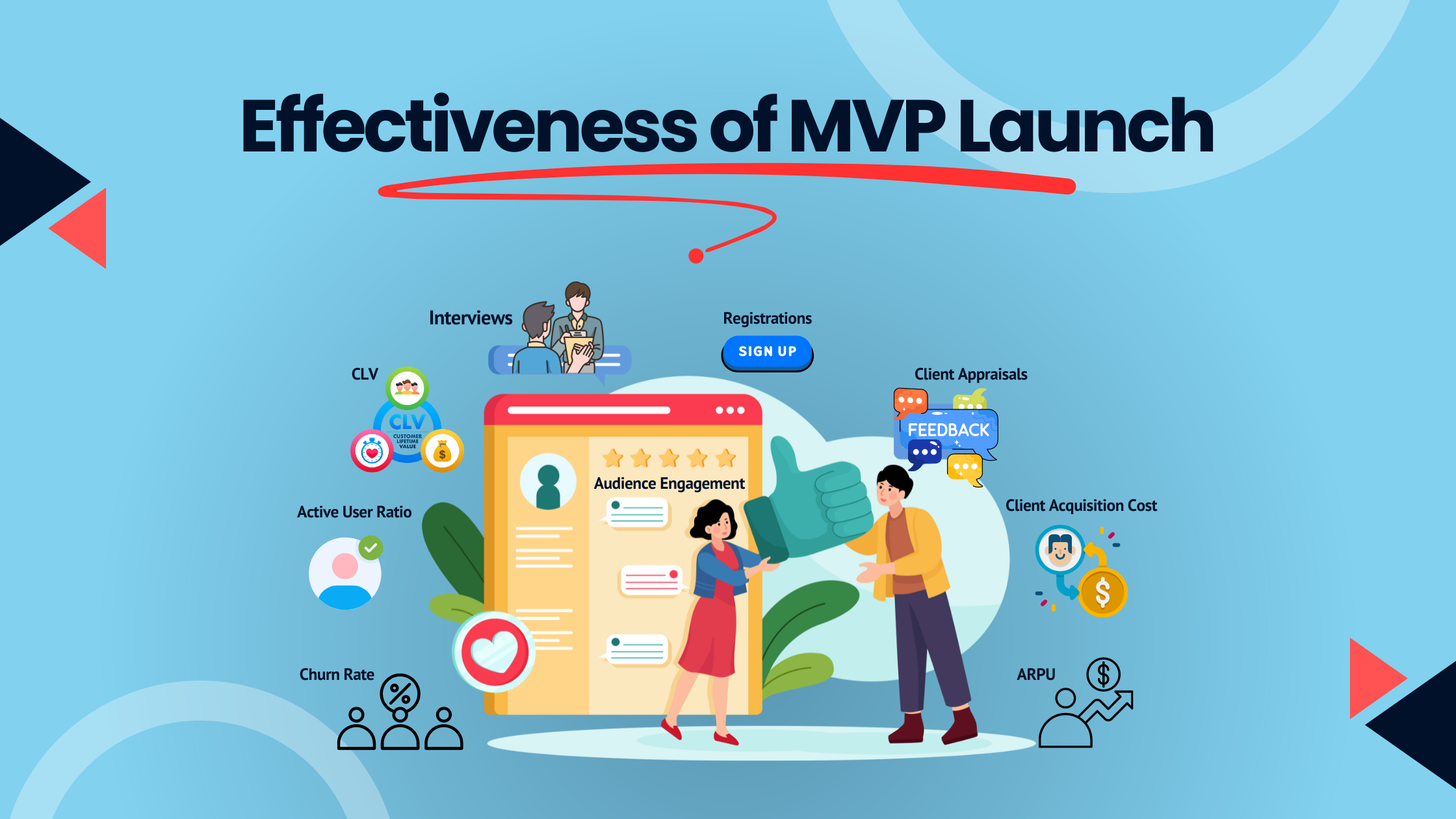
Measuring the Effectiveness of Your MVP Launch
There are various reliable approaches for accurately predicting a product's future success. Below are some of the most common, effective, and proven methods to assess the success of a minimum viable product.
Word Of Mouth
Traffic serves as an important metric for predicting success. Another effective method for tracking success is conducting interviews with potential customers. Start by identifying the challenges they are currently facing or might encounter, and then gather their feedback on these issues.
Audience Engagement
User engagement allows a startup to measure both the current value of its product and its potential future impact. It also plays a key role in enhancing the user experience by leveraging feedback for continuous improvement.
Sign Up
Registrations offer a practical way to assess user interest and can potentially translate into revenue by evaluating the level of interest in the product.
Optimizing Client Appraisals Using Feedback Insights
The number of downloads and app launch rates reflect user interest. A lighter app is likely to attract more downloads due to its ease of access and smaller size.
Active User Ratio
Download and launch rates alone don’t fully determine the success of an MVP. It’s crucial to analyze user behavior and consistently monitor the ratings from active users to gain deeper insights.
Client Acquisition Cost (CAC)
Understanding the cost of acquiring a paying customer is crucial. This allows a startup to assess the effectiveness of its marketing efforts and determine whether adjustments are needed.
CAC = Money spent on the traction channel / Number of customers acquired through the channel.
Number of Subscribed Users
Track the average revenue per user (ARPU) and monitor which products are generating revenue.
ARPU = Total income for the day and age/Number of active users
Client Lifetime Value (CLV)
Customer Lifetime Value (CLV) reveals how long a user remains active on the app before uninstalling or stopping usage
CLV = (Profit from a user *App usage duration) – Acquisition cost
Churn Rate
Churn indicates the rate or percentage of users who have uninstalled the app or ceased using it.
Churn = Number of churns per week or month / Number of users at the beginning of the week or month
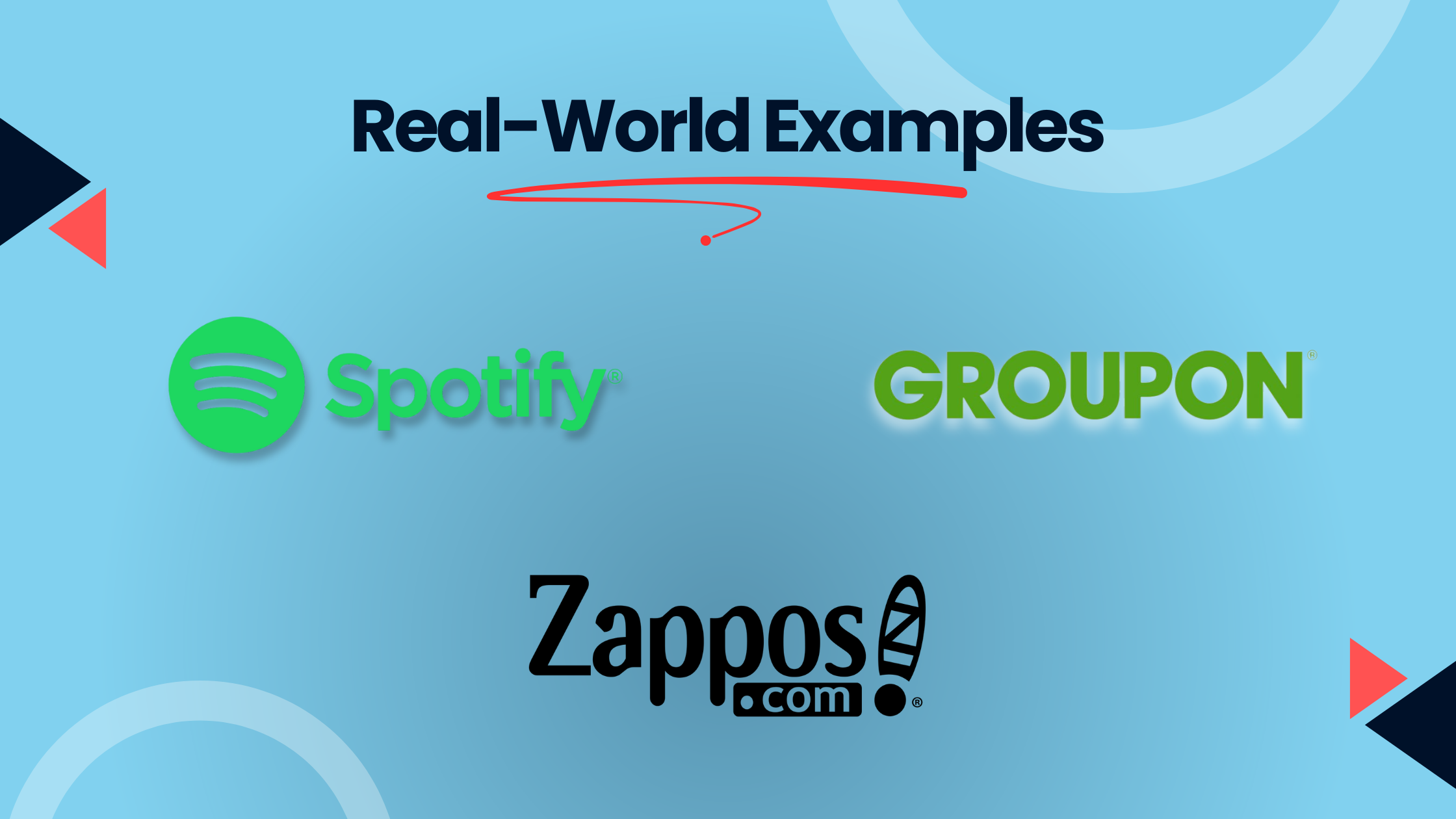
Real-World Examples Of Minimum Viable Products
Many successful companies have used the MVP building approach as a springboard, offering a practical method to test and fine-tune their business ideas. The following real-world examples demonstrate the significance of building an mvp.
Spotify
Spotify began as a simple technical prototype designed to test key assumptions: whether people were willing to stream music if artists would permit legal streaming, and whether instant playback was technically feasible. This early version, with only a few hard-coded songs and minimal features, lacked refinement but played a critical role in validating the concept. By sharing this basic MVP with friends and family, Spotify’s team quickly discovered that not only was instant, stable streaming achievable, but it was also highly desired, setting the stage for the platform’s future growth and success.
Zappos
Zappos, now a leading online shoe retailer, began with an MVP that carried no inventory. Founder Nick Swinmurn launched a website featuring photos of shoes from local stores, and would buy the shoes at a retail price once an order was placed. This strategy validated the concept of selling shoes online without requiring a large upfront investment in inventory.
Groupon
Following an initial business pivot, Groupon launched within a month by offering a two-for-one pizza deal to a small email list of 500 people. Founder Andrew Mason admitted, 'The first version wasn’t pretty,' but the concept resonated, eventually becoming Groupon’s daily deals model. This MVP building approach allowed Groupon to quickly test market interest in group buying, fueling its rapid growth and success in the deals industry
Build beyond your MVP with Expedey
Ready to elevate your minimum viable product?
Expedey provides scalable and user-friendly custom mvp software development services to help you grow and enhance your project. Our powerful infrastructure enables a seamless transition from MVP to a fully developed product, ensuring both reliability and top-tier performance.
Frequently Asked Questions
How to build an mvp?
To build a Minimum Viable Product (MVP), identify the core problem your product solves. Conduct market research to validate demand, then define the essential features required to deliver value to early users. Next, choose the right mvp development approach, such as a prototype, landing page, or basic app, and build quickly with minimal resources. Launch to a small audience, gather feedback, and use it to improve your product.
How much does it cost to build an MVP?
The cost of building an MVP depends on the project’s complexity and required features. Basic MVPs can cost around a few thousand dollars, while more advanced ones with custom functionality can cost up to fifty thousand dollars or more. Clear planning helps keep costs manageable.
How not to build an MVP?
Avoid building an MVP by trying to create a perfect full product from the start. Do not overload it with unnecessary features or spend too much time polishing designs. Skipping user feedback and failing to validate your idea early can also lead to failure. Focus on building only the essential features needed to test your core idea quickly and learn from real users.
How Do You Build an MVP in six Weeks?
Building an MVP in six weeks requires a focused and agile approach. Start by clearly defining the problem you are solving and identifying the core features necessary to deliver value. Prioritize only the essential functionalities that support your main goal. Quickly assemble a small, dedicated team, choose the right technology stack, and use lean development practices to accelerate progress. Launch a basic version early, gather user feedback, and refine based on insights.
How long should an MVP take to build?
An MVP is typically built within 3 to 4 months, although more foundational versions can take 6 to 12 months, and highly complex projects may extend up to 24 months. The MVP building process follows five essential phases: Ideation and Planning, Design and Prototyping, Development, Testing, and Deployment. Each phase plays an essential role in launching a successful minimum viable product.
What is the best framework for MVP?
The best framework for building an MVP depends on your project’s goals, budget, and technical requirements. Popular choices include React Native for mobile apps, Django and Ruby on Rails for web applications, and Flutter for cross-platform development. These frameworks offer speed, flexibility, and scalability, making them ideal for quickly validating your idea and iterating based on real user feedback.
Which programming language is best for MVP?
The best programming language for building an MVP depends on the type of product you're developing. JavaScript (with frameworks like React or Node.js) is a popular choice for web apps due to its speed and versatility. For backend-heavy MVPs, Python and Ruby are great for rapid development and clean syntax. If you’re targeting mobile apps, Swift (iOS), Kotlin (Android), or cross-platform tools like Dart (with Flutter) or JavaScript (with React Native) are ideal.
Recent Blogs
What is Meant by Trustless Transactions in Blockchain?
Discover how trustless transactions in blockchain eliminate the need for intermediaries, ensuring transparency, security, and automation through smart contracts. Explore the future of decentralized, trust-free transactions
How To Build A Responsive Website
Discover the importance of responsive web design and how to create a mobile-friendly website that adapts to any screen size. Learn essential tips to enhance user experience and boost your site's performance.
Benefits Of Using WordPress For Your Ecommerce Website
Discover the benefits of using WordPress for your ecommerce website. Learn how WordPress and WooCommerce offer flexibility, customization, and scalability to grow your online store effortlessly.
Quick Links
Our Offices

USA
12828 Willow Centre Dr Ste D #978 Houston, TX 77066
PAKISTAN
Suite # 207, 2nd Floor, Park Avenue Building, Block 6, P.E.C.H.S, Shahrah-e-Faisal, Karachi.Contact Us
© 2024 Expedey. All Rights Reserved.

